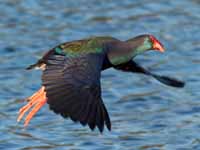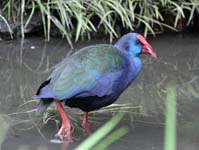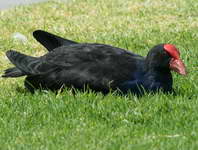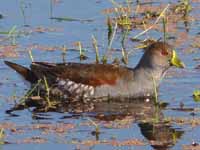BIRDS of THE WORLD - An Online Bird Book
GRUIFORMES
Family Rallidae: Coots, Moorhens
GRUIFORMES
Gruiformes means "crane-like", The order include 14 species of large cranes, about 145 species of smaller crakes and rails, as well as a variety of families comprising a small number of species.
Guiformes has the following families
Guiformes has the following families
Family Rallidae: Coots, Moorhens
Order Gruiformes Family Rallidae
The coots and moorhens of the Railidae family generally occupy dense vegetation in damp environments near lakes, swamps, or rivers. They are omnivores. Most nest in dense vegetation. Most species walk and run vigorously on strong legs, and have long toes which are well adapted to soft, uneven surfaces. Some coots and gallinules have a "frontal shield", which is a fleshy rearward extension of the upper bill. The flight of those Rallidae able to fly, while not very powerful, can be sustained for long periods of time and many species undertake annual migrations.
Genus Fulica
Coots have prominent frontal shields or other decoration on the forehead, with red to dark red eyes.. Many, but not all, have white on the under tail. They have long, lobed toes that are well adapted to soft, uneven surfaces. Coots have strong legs and can walk and run vigorously. They tend to have short, rounded wings and are weak fliers, though northern species nevertheless can cover long distances.
Coot,_Eurasian also Coot Fulica atra Found: Europe, Asia, Africa, Australia, New Zealand
The Eurasian Coot has black plumage; white frontal shield, bill.
Similar to: Black Crake. Black Crake has yellow bill and no frontal shield; Eurasian Coot has white bill and frontal shield.
Similar to: Red-knobbed Coot. Red-knobbed Coot has red knobs at top of shield during breeding season; Eurasian Coot does not. Eurasian Coot has pure white bill; Red-knobbed Coot has bill with bluish-gray tinge.
Image by: 1, 2, 3, 4) Dick Daniels - England
5) Laurie_Boyle - AustraliaSimilar to: Black Crake. Black Crake has yellow bill and no frontal shield; Eurasian Coot has white bill and frontal shield.
Similar to: Red-knobbed Coot. Red-knobbed Coot has red knobs at top of shield during breeding season; Eurasian Coot does not. Eurasian Coot has pure white bill; Red-knobbed Coot has bill with bluish-gray tinge.





Coot,_American Fulica americana Found: North Amercia to north South America
Similar to: Caribbean Coot. Carribean Coot has a white frontal shield; American Coot usually has a dark frontal shield, but this may occasionally be white on southern birds.
Similar to: Common Gallinule. American Coot is heavier, has white bill and dark frontal shield; Common Gallinule has red bill and frontal shield.
Image by: 1) Dori- California 2) Mike Baird - Cloisters City 3) Alan
D Wilson - Oregon 4, 5, 6, 9 Dick Daniels - North Carolina 7, 8) Dick - Lake Pleasant, Arizona
Similar to: Common Gallinule. American Coot is heavier, has white bill and dark frontal shield; Common Gallinule has red bill and frontal shield.









Coot Andean also Slate-colored Coot Fulica ardesiaca Found: South America
The Andean Coot has dark gray plumage; rump with little or no white. Frontal shield and bill variable in color; most common is chestnut shield, yellow bill. Found in Argentina, Bolivia, Chile, Colombia, Ecuador, and Peru.
Image by: 2, 3, 4) Dick Daniels - Otavalo, Ecuador 1, 5, 6) Nick_Athanas - Argentina1) Juvenile 6) Some have a white frontal shield






Coot,_Caribbean Fulica caribaea Found: Caribbean, Venezula and perhaps seen in North America
Similar to: American Coot. Carribean Coot has a white frontal shield; American Coot usually has a dark frontal shield, but this may occasionally be white on southern birds.
Image by: 1) Nick_Athanas - Venezuela 2) Damian Ruiz - Puerto Rico 3) Mark Stevens - Antigua1) This might be an American Coot,_but it does have the characteristics of a Caribbean Coot.



Coot,_Giant Fulica gigantea Found: South America highlands
The Giant Coot has mainly dark gray plumage; black head, neck; reddish legs. a very large coot. May be flightless.
Image by: 1, 2) Nick_Athanas 3) Robin Holler - Chile 4) Till_Niermann - Chile



Coot,_Hawaiian Fulica alai Found: Hawaii
The Hawaiian Coot's closest relative is the American Coot,_and some consider the Hawaiian Coot to a subspecies of the American. The frontal shield on the forehead is usually white, but can be yellowish or dark red.
Image by: 1, 2, 3) Dick Daniels - Kauai 4) Chris Queen - Kauai1) Yellowish frontal shield 2) Dark Red frontal shield 3, 4) White frontal shield




Coot,_Horned Fulica cornuta Found: Andes of South America
The Horned Coot has a horned shield on forehead; 3 wattles on forehead; olive-yellow bill.
Image by: 1) Olga007 2) Cornell_Univ's_Neotropical_Birds_Online - Gabriele_Vallejos

Coot,_Red-fronted Fulica rufifrons Found: South America
The Red-fronted Coot has a red frontal shield; yellow bill; dark gray upperparts; lighter gray underparts white rump. Does not favor open water.
Image by: 1) P_Khoo 2) Claudio Timm - Brazil 3) Jorge Cardenas - Chile 4) Nick_Athanas - Argentina



Coot,_Red-gartered Fulica armillata Found: South America
The Red-gartered Coot has dark gray upperparts; paler underparts; yellow bill; yellowish frontal shield; red patch between bill and shield; red "garter" on otherwise olive legs.
Image by: 1, 2, 3, 4) Dick Daniels - Chile 3) DiverDave 4) Nick_Athanas - Argentina





Coot,_Red-knobbed Fulica cristata Found: southern Europe, Africa
The Red-knobbed Coot has black plumage; white frontal shield; red knobs at top of shield during breeding seasons; whitish bill with blue-gray tinge.
Similar to: Eurasian Coot. Red-knobbed Coot has red knobs at top of shield during breeding season; Eurasian Coot does not. Eurasian Coot has pure white bill; Red-knobbed Coot has bill with bluish-gray tinge.
Image by: 1, 2) Dick Daniels - World of Birds
- South Africa 3) Craig Adam -South Africa 4) Shankar S - Kenya 5,
6) Pixlab.co.za Sportphoto.co.za - South AfricaSimilar to: Eurasian Coot. Red-knobbed Coot has red knobs at top of shield during breeding season; Eurasian Coot does not. Eurasian Coot has pure white bill; Red-knobbed Coot has bill with bluish-gray tinge.






Coot,_White-winged Fulica leucoptera Found: southern South America
The White-winged Coot has dark gray plumage; white to orange-yellow frontal shield depending on season; whitish bill; white on wing primaries difficult to see.
Image by: 1) Dario Niz in Uruguay 2) Shanthanu
Bhardwaj - Buenos Aires, Argentina 3, 4) Claudio Timm - Brazil 



Genus Gallinula
Gallinule, Common (North American) also Common Moorhen Gallinula galeata cachinnans
Found: North America. the Galápagos, Bermuda
Similar to: American Coot. American Coot is heavier, has white bill and dark frontal shield; Common Gallinule has red bill and frontal shield.
Similar to: Purple Gallinule. Common Gallinule has dark gray / black underparts; Purple Gallinule has purple underparts. Purple Gallinule has blue shield on forehead; Common Gallinule has red shield.
Image by: 1) Cuatrok 77 - Florida 2) Jason Grotty - California 4) Ken Schnieider - Florida 5) WildLifeShoots - Florida 3, 6) Dick Daniels - North Carolina 7) Dick - the Galapagos 8) Video by Avibirds. More vidoesSimilar to: Purple Gallinule. Common Gallinule has dark gray / black underparts; Purple Gallinule has purple underparts. Purple Gallinule has blue shield on forehead; Common Gallinule has red shield.
2, 3) Juvenile








Gallinule, Common (South American) also Common Moorhen Gallinula galeata galeata Found: South America
Image by: 1, 2, 3) Dario Sanches - Brazil 4) Claudio Timm - Brazil




Gallinule, Common (Antillean) Gallinula galeata cerceris Found: the Caribbean
Image by: 1) Dick Daniels - Jamaica 2) lotlhmoq - Dominican Republic 3) Raphael Robayna - Florida



Gallinule, Common (Hawaiian) Gallinula galeata sandvicensis Found: Hawaii
Image by: 1, 2, 3) Dick Daniels - Kauai, Hawaii



Moorhen, Dusky Gallinula tenebrosa Found: Australia, New Guinea
The Dusky Moorhen has dark-gray plumage with brownish tinge to the upperparts; red frontal shield; yellow tipped bill. New Guinea birds are smaller.
Similar to: Tasmanian Native-hen. Dusky Moorhen has red frontal shield; Tasmanian Native-hen has greenish-yellow frontal shield. Tamsmanian Native-hen is slimmer and a fast runner.
Image by: 1) Katerina_Tvardikova 2, 3, 4) Dick Daniels - Australia 5) Arthur Chapman 6) Benjamint444bSimilar to: Tasmanian Native-hen. Dusky Moorhen has red frontal shield; Tasmanian Native-hen has greenish-yellow frontal shield. Tamsmanian Native-hen is slimmer and a fast runner.






Moorhen,_Eurasian Gallinula chloropus chloropus Found: Europe, Asia
The Eurasian Moorhen dark plumage with white under the tail; yellow legs; red frontal shield.
Similar to: Western Swamphen. Western Swamphen has purple breast; Eurasian Moorhen has dark breast.
Image by: 1, 3) Dick -
England 2) Cristiano Crolle - Racconigi, Italy 4) Valter Jacinto - Portugal Andreas_Trepte Huhu_UetSimilar to: Western Swamphen. Western Swamphen has purple breast; Eurasian Moorhen has dark breast.
1) Chick






Moorhen, Eurasian (African) Gallinula chloropus meridionalis Found:Africa
Image by: 1, 3, 4) Dick Daniels - Birds of Eden 2) Sandy Cole - Birds of Eden 5) Monkey Boy - South Africa
1, 2, 3) Because these were Image at an aviay, they might not be the African subspecies.
1, 2) Chick 3, 4) Juvenile





Moorhen,_Lesser Gallinula angulata Found: Africa
Image by: 1) Johann_du_Preez 2) Peter_Steward - Kenya 3) Nik_Borrow - Uganda 4) Charles_Sharp - Zimbabwe
1) Juvenile




Moorhen,_Makira Gallinula silvestris Found: Solomon Islands
Image by: 1) Salvatore_Shamu

Genus Porphyrio
Porphyrio contains the gallinules and swamphens.
Gallinule, Allen's Porphyrio alleni Found: Africa
The Allen's Gallinule has purple upperparts with a greeenish back; red bill. Breeding males have a blue frontal shield; females have a green shield.
Similar to: African Swamphen. Allen's Gallinule has blue (male) or green (female) frontal shield; African Swamphen has red frontal shield.
Image by: 1) Martien Brand 2) Peter Ulbrich - Nambia 3) Jerry Oldenettel - NamibiaSimilar to: African Swamphen. Allen's Gallinule has blue (male) or green (female) frontal shield; African Swamphen has red frontal shield.



Gallinule,_Azure Porphyrio flavirostris Found: South America
The Azure Gallinule has a pale greenish-yellow frontal shield; greenish-blue wing-coverts; browner back, tail; whitish throat, underparts; yellow legs.
Image by: 1) Vincent_Vos 
Gallinule, Purple also American Purple Gallinule Porphyrio martinicus Found: South USA to north Argentina, West Indies
The Purple Gallinule has purple-blue plumage; green back; red and yellow bill with pale blue forehead shield; big yellow feet; white undertail. Juveniles are brown overall with brownish-olive back.
Similar to: Common Gallinule. Common Gallinule has dark gray / black underparts; Purple Gallinule has purple underparts. Purple Gallinule has blue shield on forehead; Common Gallinule has red shield.
Similar to: Purple Swamphen. Purple Gallinule has blue shield on forehead; Purple Swamphen has red shield. Range only overlaps in Florida where the Purple Swamphen has been introduced.
Image by: 1) Donna S - Florida 2) Linda - Florida 3) Nick_Athanas - Panama 4) Ken Schneider - Florida 5) birdphotos.com - Florida 6) Rictor Norton & David Allen - FloridaSimilar to: Common Gallinule. Common Gallinule has dark gray / black underparts; Purple Gallinule has purple underparts. Purple Gallinule has blue shield on forehead; Common Gallinule has red shield.
Similar to: Purple Swamphen. Purple Gallinule has blue shield on forehead; Purple Swamphen has red shield. Range only overlaps in Florida where the Purple Swamphen has been introduced.
1) Chicks 2, 3) Juvenile 4, 5, 6) Adult






Swamphen,_African Porphyrio madagascariensis Found: Africa, Madagascar
The African Swamphen has bronze green or green-blue back; red frontal shield; purple head, underparts.
Similar to: Allen's Gallinule. Allen's Gallinule has blue (male) or green (female) frontal shield; African Swamphen has red frontal shield.
Image by: 1, 2, 3) Derek_Keats - South Africa 7) Craig Adam - South AfricaSimilar to: Allen's Gallinule. Allen's Gallinule has blue (male) or green (female) frontal shield; African Swamphen has red frontal shield.




Swamphen,_Australasian Porphyrio melanotus Found: Australasia
The Australasian Swamphen has black back, head; red bill, frontal shield.
Image by: 1, 2) Richard Taylor - Australia 3, 4, 5) Dick Daniels - Australia 6) JJ
Harrison - Australia 7) Nik_Borrow






Swamphen,_Black-backed Porphyrio indicus Found: southeast Asia to Sulawesi and Borneo
Image by: 1) JJ Harrison - Thailand 2) D. Gordon E. Robertson


Swamphen,_Gray-headed Porphyrio poliocephalus Found: Middle East, Indian subcontinent, to southern China, Thailand
The Gray-headed Swamphen used to be considered a subspecies of the purple swamphen, which it resembles, but has a gray head, throat, upper-breast..
Image by: 1) Shantanu_Kuveskar - India 2) Raju_Kasambe - India 3) Sergey_Yeliseev - India


Swamphen,_Philippine Porphyrio pulverulentus Found: Philippines
The Philippine Swamphen used to be considered a subspecies of the purple swamphen, which it resembles, but has olive-chestnut mantle and scapulars, and the whole plumage is tinged with ash-gray.
Image by: 1, 2) Len_Worthington

Swamphen, Purple
The purple swamphen has been split into the following species:
African Swamphen: Porphyrio madagascariensis, sub-Saharan continental Africa and Madagascar
Australasian Swamphen: Porphyrio melanotus, Australia, New Zealand, and Oceania
Black-backed Swamphen: Porphyrio indicus, southeast Asia to Sulawesi
Gray-headed Swamphen: Porphyrio poliocephalus, Middle East, through the Indian subcontinent to southern China and northern Thailand
Philippine Swamphen: Porphyrio pulverulentus, Philippine islands
Western Swamphen: Porphyrio porphyrio, southwest Europe and northwest Africa
The Gray-headed Swamphen and others have been introduced into Florida. Below are photos of some swamphens that have been found in the wild in the USA.
Similar to: Purple Gallinule. Purple Gallinule has blue shield on forehead; Purple Swamphen has red shield. Range only overlaps in Florida where the Purple Swamphen has been introduced. Florida subspecies is P. p. poliocephalus.
Image by: 1, 2) Kenneth_Cole_Schneider - Florida 3) Gene_Wilkinson - GeorgiaAfrican Swamphen: Porphyrio madagascariensis, sub-Saharan continental Africa and Madagascar
Australasian Swamphen: Porphyrio melanotus, Australia, New Zealand, and Oceania
Black-backed Swamphen: Porphyrio indicus, southeast Asia to Sulawesi
Gray-headed Swamphen: Porphyrio poliocephalus, Middle East, through the Indian subcontinent to southern China and northern Thailand
Philippine Swamphen: Porphyrio pulverulentus, Philippine islands
Western Swamphen: Porphyrio porphyrio, southwest Europe and northwest Africa
The Gray-headed Swamphen and others have been introduced into Florida. Below are photos of some swamphens that have been found in the wild in the USA.
Similar to: Purple Gallinule. Purple Gallinule has blue shield on forehead; Purple Swamphen has red shield. Range only overlaps in Florida where the Purple Swamphen has been introduced. Florida subspecies is P. p. poliocephalus.



Swamphen,_Western Porphyrio porphyrio Found: southern Europe, Morocco, Tunusia
The Western Swamphen has mainly purple plumage; red bill, frontal shield.
Similar to: Eurasian Moorhen. Purple Swamphen has purple breast; Eurasian Moorhen has dark breast.
Image by: 1) sighmanb - Portugal 2) Andreas_TrepteSimilar to: Eurasian Moorhen. Purple Swamphen has purple breast; Eurasian Moorhen has dark breast.


Takahe Porphyrio hochstetteri Found: South Island of New Zealand
The Takahe is the largest living member of the family Rallidae. It has mainly bluish-purple plumage with a greenish back; red frontal-shiled; pink legs. Juvenile has mainly brown plumage.
Image by: 1) Peter Harrison 2, 4) Digitaltrails 3) Ashleigh_Thompson 1) Juvenile




Genus Porphyriops - 1 species
Gallinule, Spot-flanked Porphyriops melanops Found: South America
The Spot-flanked Gallinule has brown flanks with white spots; chestnut upperparts; brownish-gray head, neck; gray underparts; green frontal shield, bill.
Image by: 1) Joshua Stone - Vina del Mar,
Chile 2, 4, 5) Cláudio Timm - Brazil 3) Carlos Bussenius 6) Nick_Athanas - Columbia1) Juvenile






Genus Tribonyx
Native-hen,_Black-tailed Tribonyx ventralis also Gallinula ventralis Found: Australia, New Zealand
The Black-tailed Native-hen has an erect tail; brownish-gray and green plumage; pink-orange legs; green frontal shield, bill; white streaks on flanks.
Similar to: Tasmanian Native-hen. Black-tailed Native-hen has green bill; Tasmanian Native-hen has yellow bill.
Image by: 1) Steve_Elson 2) Ron Knight 3) Arthur Chapman - Australia 4) Sunphlo 5) Ed_Dunens 6) Nik_Borrow 7) Laurie_BoyleSimilar to: Tasmanian Native-hen. Black-tailed Native-hen has green bill; Tasmanian Native-hen has yellow bill.







Native-hen, Tasmanian Tribonyx mortierii also Gallinula mortierii Found: Tasmania
The Tasmanian Native-hen has olive-brown upperparts with white patch on flank; darker underparts with bluish-gray tinge; red eyes; greenish-yellow frontal shield; yellow bill.
Similar to: Black-tailed Native-hen. Black-tailed Native-hen has green bill; Tasmanian Native-hen has yellow bill.
Similar to: Dusky Moorhen. Dusky Moorhen has red frontal shield; Tasmanian Native-hen has greenish-yellow frontal shield. Tamsmanian Native-hen is slimmer and a fast runner.
Similar to: Australasian Swamphen. Purple Swamphen has red bill; Tasmanian Native-hen has yellow bill.
Image in Tasmania by: 1) Ways 2) Felix Wilson 3) Nik_Borrow 4, 6) JJ Harrison 5) Arthur Chapman 7) Charlie Westerinen Similar to: Black-tailed Native-hen. Black-tailed Native-hen has green bill; Tasmanian Native-hen has yellow bill.
Similar to: Dusky Moorhen. Dusky Moorhen has red frontal shield; Tasmanian Native-hen has greenish-yellow frontal shield. Tamsmanian Native-hen is slimmer and a fast runner.
Similar to: Australasian Swamphen. Purple Swamphen has red bill; Tasmanian Native-hen has yellow bill.
1) Eggs 2) Chick






